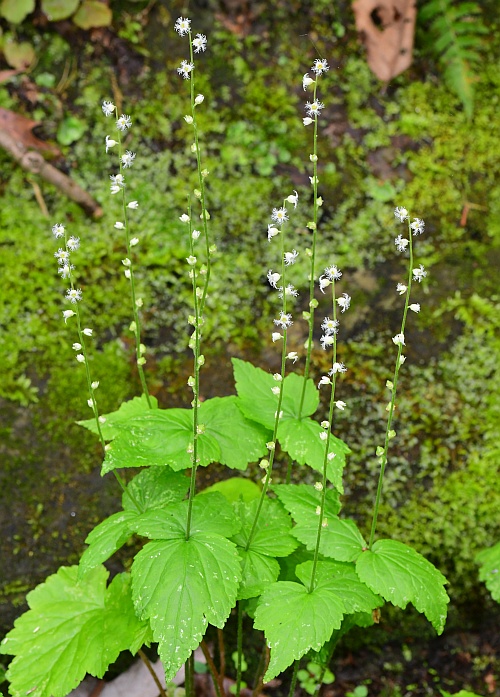Mitella diphylla L.
Miterwort

Native
CC = 8
CW = 3
MOC = 19
© SRTurner
Mitella diphylla L.Miterwort | |
 |
Native CC = 8 CW = 3 MOC = 19 |
© SRTurner |
|
Family - Saxifragaceae Habit - Perennial forb with with short, stout rhizomes. Stem - Absent. Apparent stem is the inflorescence stalk. Leaves - All basal. Stipules 1-5 mm long, scalelike, ovate, the margins entire to somewhat irregular. Leaf blades 1-9 cm long, about as long as wide, ovate to nearly circular, the base cordate, the tip rounded or pointed, the margins usually with 3 or less commonly 5 shallow lobes, also finely to coarsely scalloped or toothed, palmately veined with mostly 5 primary veins, the upper surface glabrous to moderately hairy, sometimes sparsely glandular toward the base, green, the undersurface sparsely to moderately hairy and glandular, especially along the veins, pale green to grayish green.
Inflorescence - Erect spikelike racemes to 40 cm long, with 5-20 flowers, long-stalked. Stalks moderately to densely pubescent with minute stalked glands below a single pair of bracteal leaves, also with longer, spreading to downward-pointing hairs having minute glandular tips.
Flowers - Actinomorphic, perfect, perigynous, subtended by a minute oblong-ovate bract. Hypanthium shallowly bell-shaped, fused to the basal portion of the ovary. Sepals 1.0-1.5 mm long, oblong-triangular, glabrous, greenish white. Petals 2.0-2.5 mm long, deeply pinnately dissected into linear segments, glabrous, white. Stamens 10, much shorter than the calyx, the anthers small, pale yellow. Ovary 1-locular in the fused portion, the placentation parietal. Styles short, the stigmas crescent-shaped or lozenge-shaped.
Fruits - Capsules 2.5-3.0 mm long, broadly ovoid, 2-beaked, dehiscing longitudinally from between the beaks. Seeds 5 to numerous, 0.8-1.2 mm long, narrowly obovoid, somewhat angular, the surface appearing smooth, black, shiny.
Flowering - April - June. Habitat - Bases and ledges of north-facing bluffs. Origin - Native to the U.S. Lookalikes - Broadly, species of Heuchera, Micranthes, and Sullivantia. Other info. - This delicate and beautiful species is uncommon in Missouri, found mostly in the Ozarks and in a few eastern counties near the Missouri River. It is much more common in the upper Midwest and Northeast, and in fact Missouri is near the southwestern corner of the plant's natural range. Photographs taken at the Walls of Jericho, AL, 3-4-06 (DETenaglia); also at Pacific Palisades Conservation Area, Jefferson County, MO, 4-12-2010 and 4-21-2025 (SRTurner). Fruit photos of cultivated plants courtesty of Kathy Bildner. |